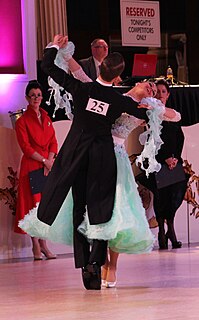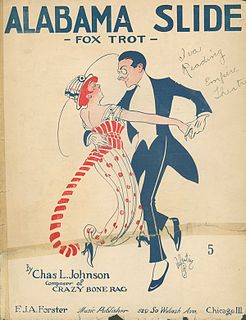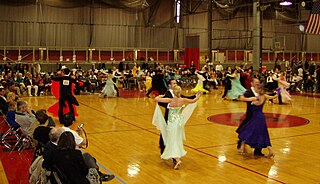Related Research Articles

Ballroom dance is a set of partner dances, which are enjoyed both socially and competitively around the world, mostly because of its performance and entertainment aspects. Ballroom dancing is also widely enjoyed on stage, film, and television.

The foxtrot is a smooth, progressive dance characterized by long, continuous flowing movements across the dance floor. It is danced to big band music. The dance is similar in its look to waltz, although the rhythm is in a 4
4 time signature instead of 3
4. Developed in the 1910s, the foxtrot reached its height of popularity in the 1930s and remains practiced today.

Dancesport is competitive ballroom dancing, as contrasted to social or exhibition dancing. In the case of wheelchair dancesport, at least one of the dancers is in a wheelchair.
Rhumba, also known as latin rumba, is a genre of latin music and dance that appeared in the East Coast of the United States during the 1930s. It combined American big band music with Afro-Cuban rhythms, primarily the son cubano, but also conga and rumba. Although taking its name from the latter, ballroom rumba differs completely from Cuban rumba in both its music and its dance. Hence, authors prefer the Americanized spelling of the word (rhumba) to distinguish between them.

The Imperial Society of Teachers of Dancing (ISTD) is an international dance teaching and examination board based in London, England. The registered educational charity, which was established on 25 July 1904 as the Imperial Society of Dance Teachers, provides training and examinations in a range of dance styles and certified dance teacher courses. The ISTD is recognised by the Qualifications and Curriculum Authority and the Council for Dance Education and Training and is also a member of the British Dance Council. It hosts various competitions in many different formats including Modern Ballroom, Latin American, Classical Ballet and Tap Dance as well as contemporary styles like Disco Freestyle.
In many forms of dance medal examinations are held. They are organised by leading dance teaching organisations, such as the Imperial Society of Teachers of Dancing (ISTD), the International Dance Teachers Association (IDTA), and other organisations.

Waltz is one of the five dances in the Standard category of the International Style ballroom dances. It was previously referred to as slow waltz or English waltz.

The United States national professional ballroom dance champions are crowned at the United States Dance Championships, as recognized by the National Dance Council of America (NDCA) and the World Dance & DanceSport Council (WD&DSC).
The United States national professional ballroom dance champions are crowned at the United States Dance Championships, as recognized by the National Dance Council of America (NDCA) and the World Dance & DanceSport Council (WD&DSC).
The United States national professional ballroom dance champions are crowned at the United States Dance Championships, as recognized by the National Dance Council of America (NDCA) and the World Dance & DanceSport Council (WD&DSC).
The United States national professional ballroom dance champions are crowned at the United States Dance Championships, as recognized by the National Dance Council of America (NDCA) and the World Dance & DanceSport Council (WD&DSC).
The United States national professional ballroom dance champions are crowned at the United States Dance Championships, as recognized by the National Dance Council of America (NDCA) and the World Dance & DanceSport Council (WD&DSC).
Gwenethe Walshe was a leading British Latin and ballroom dancer. Born in Wanganui, New Zealand, she lived most of her life in England and moved to Australia after her retirement. She arrived in England in 1936, and by 1938 she had founded a dance school bearing her name in London's West End, which is still operating as the Central London Dance. During World War II she worked by day as a WVS nurse and by night continued to run classes, even during air raids. Gwenethe simply turned up the music and the dancing continued!
The British Dance Council was formed in 1929 as the Official Board of Ballroom Dancing (OBBD). The name was changed in 1985 to the British Council of Ballroom Dancing and in 1996, the name was changed to British Dance Council. The BDC is the recognised governing body for Ballroom, Latin American, Sequence & Freestyle Disco dance in the United Kingdom.
Ballroom tango is a ballroom dance that branched away from its original Argentine roots by allowing European, American, Hollywood, and competitive influences into the style and execution of the dance.

The BYU Ballroom Dance Company originates in the Department of Dance of the College of Fine Arts and Communications at Brigham Young University (BYU) in Provo, Utah. It has been a part of BYU for nearly 50 years and competes and performs throughout the world.
The annual United States Dance Championships (USDC), previously called the United States Ballroom Championships (USBC) and the United States DanceSport Championships (USDSC), is recognized by the National Dance Council of America (NDCA) and the World Dance & DanceSport Council (WD&DSC) as determining the majority of the United States national professional ballroom dance champions.
Monsieur Pierre was the professional name of Pierre Jean Phillipe Zurcher-Margolle. He was a professional dancer and dance teacher, largely responsible for introducing the Latin American dances to England, and for codifying them, and laying the groundwork for their use in competitions and in social dance. The system he and his colleagues developed became the basis for all Latin and American competitions held under the World Dance Council (WDC).
Josephine Bradley MBE was a ballroom dancer and dance teacher. Although born in Dublin, she was raised from an early age in London, the youngest of eight children. Bradley was among the first ballroom dance professionals of the Imperial Society of Teachers of Dancing (ISTD) who standardised the basic techniques of foxtrot, tango, quickstep and waltz. These are the English ballroom dances of what is now the World Dance Council's International Dancesport category. For her activities she had earned herself an informal title "The First Lady of the Ballroom".
Dimitri Petrides was a ballroom dancer who was instrumental in pioneering and developing Latin American dancing in England and later globally. He left Cyprus when he was eighteen with his mother after the death of his father, eventually settling in England. He was one of the founding members of the Latin-American Faculty of the Imperial Society of Teachers of Dancing, and wrote the first English textbook on the subject. He was a Fellow and Examiner of the ISTD.
References
- ↑ Janet Sturman The SAGE International Encyclopedia of Music and Culture - 2019 - - Page 318 "Eventually, an organization fulfilling a function similar to ISTD's for the United States, the National Dance Council of America, was formed in 1948. It set strict standards for ballroom dance teachers, competitions, and ..."
2. Official website: https://www.ndca.org/